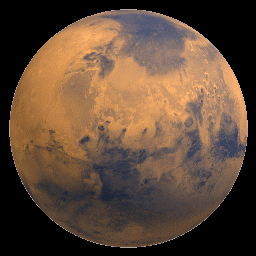
Mars
Mars is the fourth and last of the terrestrial (inner) planets.
It was nicknamed the "Red Planet" because of the large
amounts of iron oxide (rust) that are scattered around the planet
(2). Mars has proved to be the most Earth-like of all the other
planets in the solar system. The Martian soil is similar to
Earth’s (1) and Mars also shows a pattern of seasons similar
to our own (2). There are also many volcanoes on Mars, including
the largest one in the solar system, Olympus Mons (27 km high and
600 km across)(3), which is wider than Hawaii and is three times
the size of Mt. Everest (1). Some volcanoes in one part of Mars
are so large that they deformed the planet’s sphericity (3).
These volcanoes may have poured out steam, fell as rain, made
rivers, and gouged out channels, however there is no liquid water
there today (1). An enormous canyon on Mars is the Valles
Marineris, which is 240 km wide at one point and is 6.5 km deep
(1). It is so big, it would stretch from California to New York,
and the Grand Canyon would easily fit into one of the side
canyons of this great chasm (3). There are ice caps on both poles
of Mars, the northern one being made mostly of water which never
melts, and the southern one being made of carbon dioxide which
melts in the summer (1). Because of all of these things, it was
concluded that Mars’ surface is the most varied of all the
terrestrial planets besides Earth.
The atmosphere on Mars is very thin, the density of it being less
than one percent of Earth’s (2). The atmosphere that exists
is made of 95% carbon dioxide with some nitrogen and argon also
existing. There is very little oxygen and water vapor on Mars,
although some does exist (1). The climate on Mars varies greatly
from season to season, mostly because of its elliptical orbit
(2). Temperatures on Mars can range from 30º C to -130º C.
Winds are common on Mars that blow at speeds of up to 200km/h.
The dust stirred up from these storms make the sky look pink (1).
Mars is 228 million km from the sun and has a diameter of 6794
km. Its year is 1.88 Earth years long, and there are 24.5 hours
in a day. Mars has two small moons, Phobos and Deimos (meaning
fear and terror), that are rocky and crater covered. Phobos is 25
km in diameter and Deimos is 15 km in diameter.
